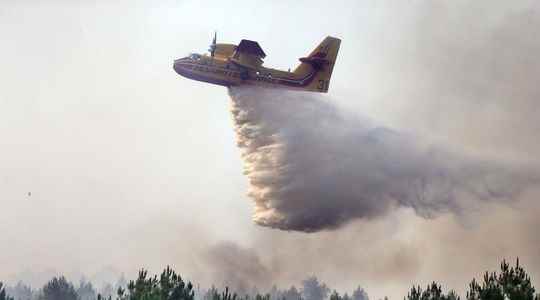How small man seems in front of these thirty meter high megafires, circulating from tree to tree at breakneck speed. And how difficult it is for the 1,700 firefighters, the six canadairs and the three Dash planes to contain these tireless rolls of flames, which have so far devastated 17,000 hectares of forest in the Gironde department, and forced the evacuation of 32,000 people in one week. But why is it so difficult to “fix a fire”, as the formula says, when the common imagination would like to see in the massive use of water the sure way to overcome it?
Unfavorable climatic conditions for fire control
Since July 12 and the outbreak of the two fires in the Gironde towns of Landiras and La Teste-de-Buch, not a drop of rain has fallen in the region. Worse, the thermometer has only increased, forcing the authorities to place the department on heatwave red vigilance on Sunday July 17. To make matters worse, strong 360-degree winds have come in recent days to undermine the efforts of the firefighters deployed around Landiras. “The situation is so fluid that the strategic plan must be reassessed half-day by half-day. If resources are engaged on the right flank of a forest fire and if the wind suddenly changes 90 degrees to go due west for example, all our plans are to be reviewed”, explains the spokesperson for Civil Security, Alexandre Jossard, in the columns of Figaro.
Long concentrated in the Mediterranean arc, from Corsica to the Pyrenees, the risk of fire continues to spread, and the cause is global warming. “Due to a relatively mild climate so far, the risk of fire remained moderate in Gironde. With the rise in temperatures, it will increase sharply in the coming years”, explains to L’Express Jean-Louis Pestour, manager National Forest Fire Department at the National Forestry Office. In an attempt to smother this Girondin fire, the Minister of the Interior, Gérald Darmanin, announced this Sunday the dispatch of 200 firefighters as reinforcements. So, in parallel with these unfavorable climatic conditions, a question arises: are we lacking the material and human resources to fight fires?
Equipment unsuited to new climate challenges
Here is the inventory of the material forces: France has, in all, 19 water bomber planes, two water bomber helicopters, twelve Canadair and six operational Dash, a seventh having just been delivered. Currently, nearly half of this fleet is mobilized on the two lights of Gironde. The finding is cause for concern, what would we do if similar fires broke out at the same time in other regions? Alexandre Jossard confides to AFP that “France is one of the best endowed countries in Europe”, but specifies, indeed, that “its capacities nevertheless remain limited”.
Several problems arise, and they are not new. In the summer of 2019, professional firefighters in France had, for the vast majority of them, signed a strike notice in order to protest in particular against the lack of staff – there are fewer volunteer firefighters in France than in Austria – and the bad distribution of the material on the territory. Year-round, the entire firefighting air fleet is based in Nîmes, in the Gard, a department regularly plagued by forest fires. And if, during the summer, two Canadair are detached to Corsica, this extreme concentration of forces is surprising. When the fire broke out in Gironde, the planes took two hours to come. However, all firefighters agree that a reaction from the first minutes of a fire is essential for its future control.
Another point of tension, the aging of the equipment, the subject of a document sent by the national federation of firefighters of France to the candidates for the presidential election of 2022. In this text, it called for “the modernization of the 12 Canadair”, two-thirds of them are over 25 years old, and “the renewal of 16 water bomber planes”, in order to be able to fight against “the future demands of the climate challenge”.
In this fight that has already begun, the action of the man upstream is also crucial. “There is a whole series of preventive works against forest fires. For example, moving trees away from each other or clearing low branches”, explains to L’Express Christophe Chantepy, expert at the pole of Protection of forests against fires within the National Forestry Office.
The objective is clear: to prevent the forest from turning into a tsunami of fire. Because the arboreal nature of forests matters. So the pines tend to burn easily, when the cork oak proves to be more resistant, due to the thickness of its trunk. According to several experts, the Bordeaux forest was not maintained enough, and the idea of devoting a ministerial delegation to Civil Security, like what exists for Road Safety, is becoming a serious hypothesis. Global warming is about to impose its agenda and it could well oblige the State to make the fight against forest fires a national cause.
